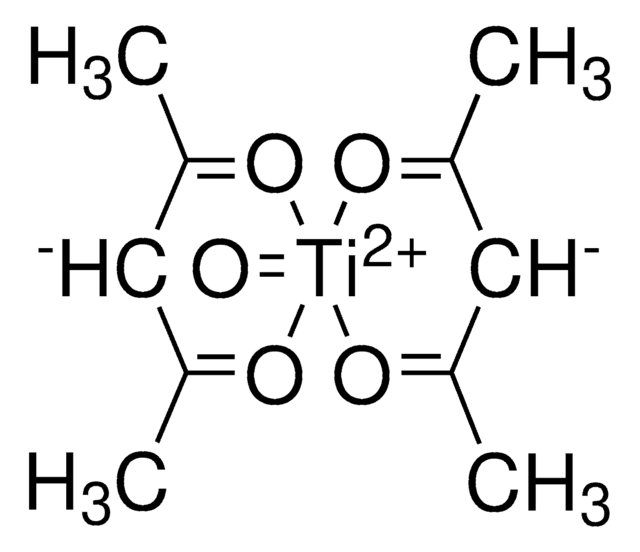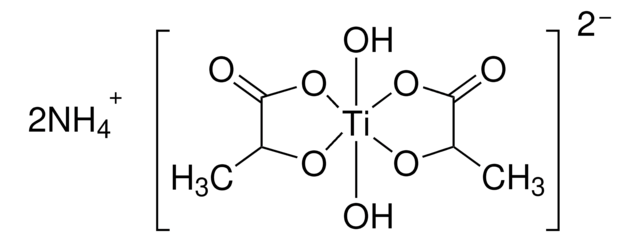325252
Titandiisopropoxid-bis(acetylacetonat)
75 wt. % in isopropanol
Synonym(e):
Diisopropyloxytitan-bis-(acetylacetonat) -Lösung, TYZOR® AA organisches Titanat, Ti(acac)2OiPr2
About This Item
Empfohlene Produkte
Form
solution
Zusammensetzung
Ti, 9-10.5% gravimetric
Eignung der Reaktion
core: titanium
reagent type: catalyst
Konzentration
75 wt. % in isopropanol
Brechungsindex
n20/D 1.4935
Dichte
0.995 g/mL at 25 °C
SMILES String
CC(C)O[Ti](OC(C)C)(O\C(C)=C\C(C)=O)O\C(C)=C\C(C)=O
InChI
1S/2C5H8O2.2C3H7O.Ti/c2*1-4(6)3-5(2)7;2*1-3(2)4;/h2*3,6H,1-2H3;2*3H,1-2H3;/q;;2*-1;+4/p-2/b2*4-3+;;;
InChIKey
OVSGBKZKXUMMHS-VVDZMTNVSA-L
Suchen Sie nach ähnlichen Produkten? Aufrufen Leitfaden zum Produktvergleich
Anwendung
Rechtliche Hinweise
Signalwort
Danger
H-Sätze
Gefahreneinstufungen
Eye Dam. 1 - Flam. Liq. 2 - STOT SE 3
Zielorgane
Central nervous system
Lagerklassenschlüssel
3 - Flammable liquids
WGK
WGK 3
Flammpunkt (°F)
53.6 °F - closed cup
Flammpunkt (°C)
12 °C - closed cup
Persönliche Schutzausrüstung
Eyeshields, Faceshields, Gloves, type ABEK (EN14387) respirator filter
Analysenzertifikate (COA)
Suchen Sie nach Analysenzertifikate (COA), indem Sie die Lot-/Chargennummer des Produkts eingeben. Lot- und Chargennummern sind auf dem Produktetikett hinter den Wörtern ‘Lot’ oder ‘Batch’ (Lot oder Charge) zu finden.
Besitzen Sie dieses Produkt bereits?
In der Dokumentenbibliothek finden Sie die Dokumentation zu den Produkten, die Sie kürzlich erworben haben.
Kunden haben sich ebenfalls angesehen
Artikel
Few Monolayer Atomic Layer Deposition (ALD) on Surfaces and Interfaces for Energy Applications
Titanium dioxide applications: Semiconducting material characteristics and diverse functionalities.
The properties of many devices are limited by the intrinsic properties of the materials that compose them.
Unser Team von Wissenschaftlern verfügt über Erfahrung in allen Forschungsbereichen einschließlich Life Science, Materialwissenschaften, chemischer Synthese, Chromatographie, Analytik und vielen mehr..
Setzen Sie sich mit dem technischen Dienst in Verbindung.












